Gluten Free Easy, Easy, Easy! French Bread Recipe
Updated Jun 09, 2025, Published Nov 11, 2011
This post contains affiliate links. Please see our disclosure policy.
Today is supposed to be a very lucky day – 11/11/11. And personally, I am inclined to believe it. It was lucky for me and I think lucky for you. I had a gluten free bread baking recipe breakthrough.
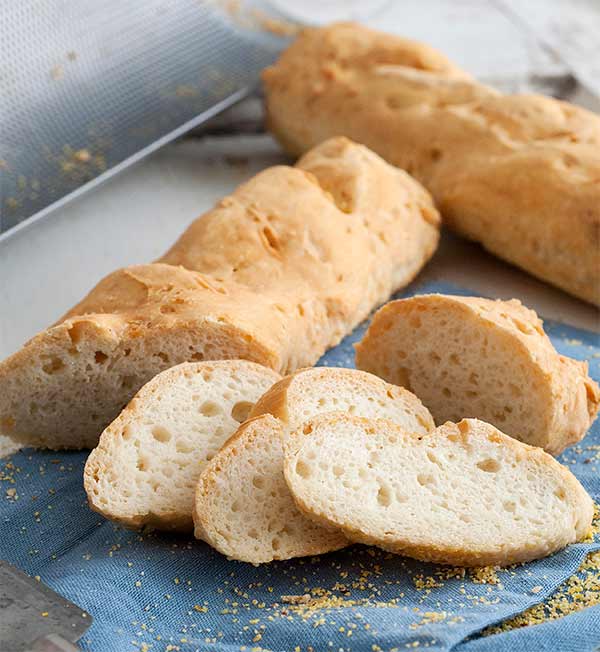
As a person who spends most of her time creating gluten free recipes you can imagine that I get my fair share of emails asking if I have a really good recipe for gluten free bread. Before going gluten free I made a few loaves of bread (with varying degrees of success) but I was by no means a bread baker. When I get these emails I think “Why ask me? Why not ask a bread baking expert?”
But the more I thought about it, the more I realized, I am probably the perfect person to ask. Why? Because:
1. I went for probably 15 years without eating bread so I know I can live without it – I would rather not eat bread than eat yucky, grainy, crumbly bread.
2. I love great food but I am also kind of lazy so I am always looking for the easiest way to make something.
3. I am not a person who finds it “relaxing” to knead dough by hand for 15 minutes. I wish I was that kind of person, but sadly when I do menial tasks for any period of time, my mind starts to wander and that is never a good thing!
4. I am success driven, persistent and some might even say a little OCD – I will keep at something until I get it right.
So, I decided to put my mind to making great gluten free breads. I decided to start with gluten free French Bread. I did my homework, I studied first the traditional French Bread recipes and methods, then I looked at gluten free ingredients and studied how to make them work better and finally, I baked and baked and baked!
I played around with flours and baking times and methods until I got a gluten free French Bread recipe that was crunchy on the outside, tender on the inside, beautifully browned, tastes like what French Bread should taste like and was easy to make. I threw away a lot of bread, enlisted everyone I came across (including a good number of whom are regular gluten-eaters) in blind taste testing and finally, I am pleased to say, came up with a recipe I am happy with! And I think YOU will love!
And you want to hear the very best thing? It is actually EASIER to make gluten free French Bread than it is to make the gluten-filled kind! Yes, you heard right – EASIER! No kneading, no double rising (I tried, better without) no hours until bread is ready. You can actually have lovely, perfect gluten free French Bread in about an hour and a half, start to finish!
Ok… so here are some tips I discovered:
Equipment
You are going to need a mixer – it is going to do pretty much all the work for you. You also need a French bread pan – gluten free bread needs support when it is rising and baking. Fortunately, you can get one for under $20.00 – considering the cost of decent gluten free bread, an investment so worth it! The pans come either perforated or solid, I used both in testing and it didn’t make a huge difference but I did like the results from the perforated pans slightly more. And finally, unless you are dead certain your oven is totally accurate, run over to the hardware or grocery store and grab an oven thermometer for about 4 bucks – you should have one anyway!
Kneading
Remember when the internet was all abuzz about no-knead bread? Ha! That’s old news to us gluten free bakers! 3 minutes in the mixer and that’s pretty much it, no kneading what-so-ever!
Yeast
I got the best result from Dry Active Yeast. It needs to be “active” so if you have had a jar sitting in your fridge since you can’t remember when, go get a new one – it lasts about 6 months refrigerated, after that it may not be good any longer. If you do store your yeast in the fridge then it will take longer for the yeast to “proof.” You want the yeast mixture to pretty much double in size and be all foamy.
Flours
After testing all sorts of different flour combinations, what worked best was a simple combo of white rice flour, sweet rice flour (also called glutinous flour) and tapioca starch. I used all Asian flours (Erawan Brand) which are more finely milled and cost a fraction of the flours you get in the health food store. I also tested this recipe using my own flour and it came out really great (well…dahaaa!) and the dough was a tad easier to work with.
Gum and Fat
I found that mixing the xanthan gum with the fat (olive oil) before adding it to the batter made it work better. I wish I could tell you why, just trust me on this.
Prep
Get all your ingredients out, mix your yeast, blend the xanthan gum with the oil and lightly beat your eggs before you start to mix, it makes it easier. Do the steps in order as I give you in the recipe.
The Dough
If you were used to bread making in a former pre-gluten-free life you will think there is not enough flour in the dough because it has a consistency more like a thick batter than dough. Resist with every fiber of your being from adding more flour! This is just the way gluten free bread dough is. You need to spoon the dough into the pans and shape it with a spatula – it won’t magically turn into pretty ovals unless you do this.
Slashing the Dough
Cutting 3 or 4 diagonal slashes into the top of the dough will help the steam escape while it is baking giving you a lovely, tender texture.
Prepping the Pans
Either spray your French Bread pans with gluten-free, non-stick cooking spray or brush with oil before putting the dough into the pans to rise. For a really authentic bottom, sprinkle a teaspoon of cornmeal on the bottom of the pans after you oil them up. It isn’t completely necessary but it does add that certain je ne se qua (fancy French term for “a certain something”). If using the perforated pans, place them on top of a baking sheet to oil and dust with cornmeal or you will have a mess to clean. Do not bake the bread on the baking sheet however, just put the French bread pan right on the oven rack.
Browning
I tested everything I could think of to get the perfect brown on the French Bread and what I found gave the best color came from brushing the loaves with melted butter just before baking. The good news is that they also came out beautifully browned with a brushing of melted Earth Balance as well – keeping the bread totally dairy free if need be.
Humidity
To get that crunchy crust and tender inside so characteristic of good French Bread it should bake in a humid environment. This is easily created by putting a pan of hot water into the oven while it preheats and just leaving it there while the bread is baking. You can also spritz the oven occasionally with water from a spray bottle but then you have to remember to do it whereas the pan of water just sits there and does its job.
Here’s how the whole thing goes:
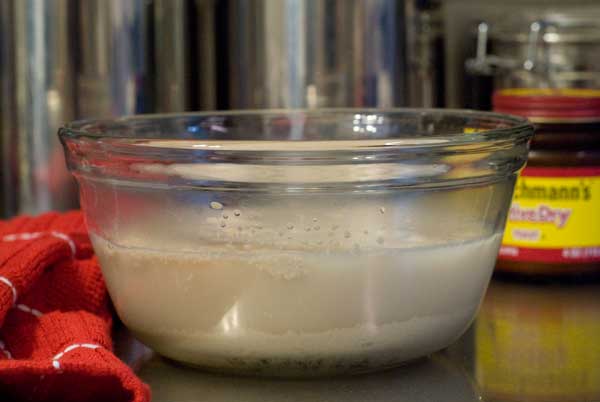
Mix the yeast, sugar and warm water – whisk to dissolve.
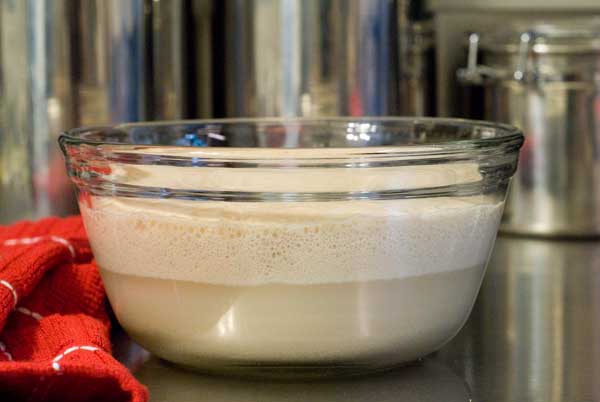
Let the yeast “proof” until foamy and doubled in volume.
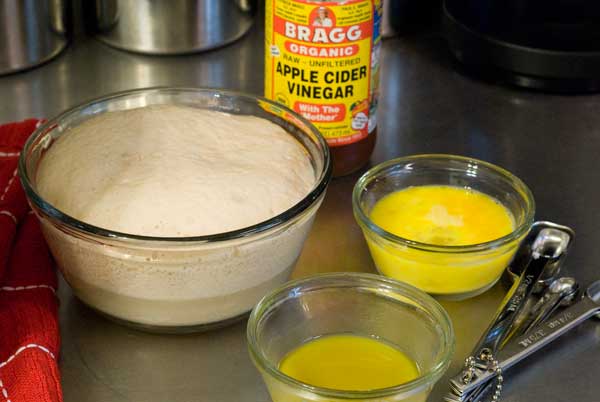
Get all your ingredients ready before mixing.
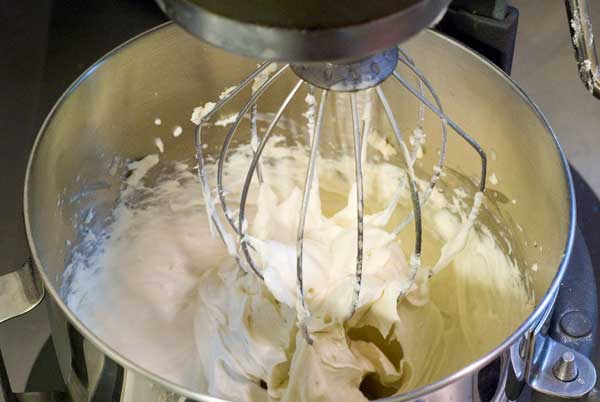
The dough will look more like batter than dough.
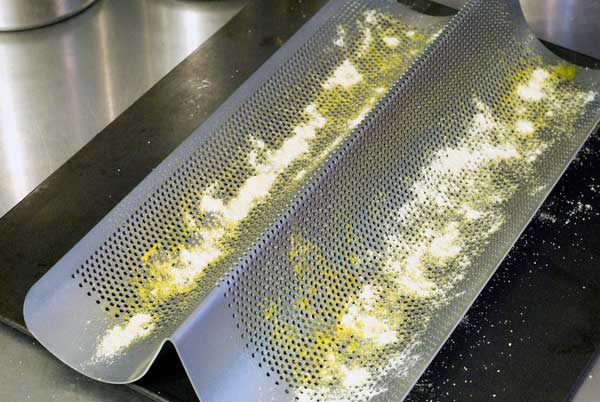
Grease the pan with oil and sprinkle with some cornmeal.
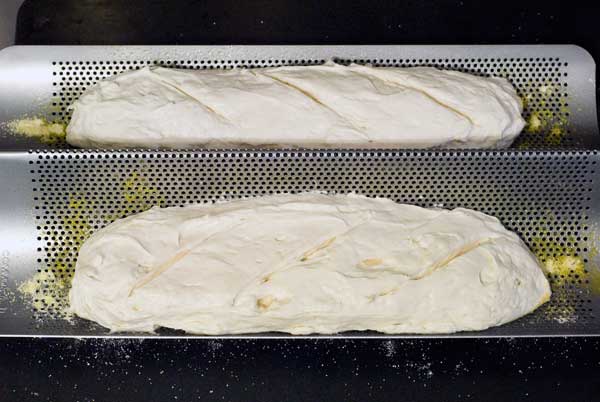
Spoon batter into pans, shape into ovals and slash the top 3 or 4 times.
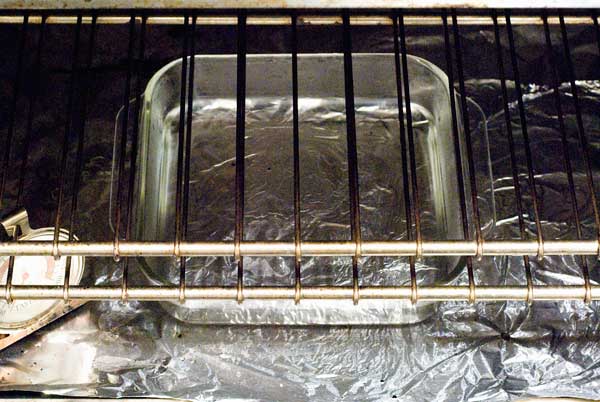
Place a pan of hot water into the bottom of oven.
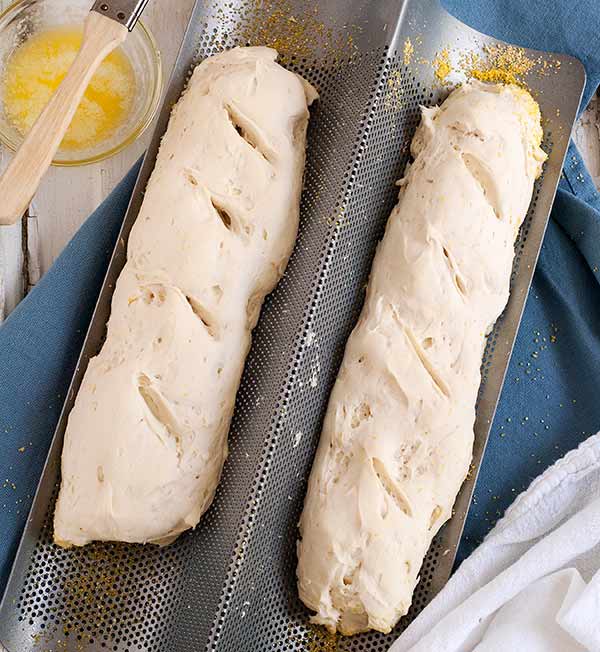


Gluten Free Easy, Easy, Easy! French Bread Recipe
Ingredients
- 2 tablespoons Dry Active Yeast
- 2 teaspoons sugar
- 1½ cups warm water, it should be pretty warm to the touch but not hot
- 3 teaspoons xanthan gum
- 2 tablespoons olive oil
- 1½ cups super fine or Asian white rice flour*
- ½ cup superfine or Asian sweet rice flour*
- 1 cup tapioca starch*
- 1½ teaspoons kosher or fine sea salt
- 2 large eggs, lightly beaten
- 1 teaspoon apple cider vinegar
- 2 teaspoons cornmeal, optional
- 2 tablespoons butter or Earth Balance, melted
Instructions
- Combine the yeast, sugar and warm water in a bowl about twice the size of the mixture and whisk to dissolve the sugar. Let sit for 5-6 minutes (10 if the yeast has been in the fridge) or until it is foamy and doubled in size.
- In a small bowl stir the xanthan gum with the olive oil until the xanthan gum is dissolved.
- Combine the flours, tapioca starch (or gluten free flour blend) and salt in the bowl of a mixer fitted with a whisk attachment (or just the regular beaters – don’t use a dough hook) and mix to combine. Add the yeast mixture, xanthan gum mixture, eggs and vinegar and mix on low to combine. Scrape down the sides of the bowl once. Turn the mixer to high and mix for 3 minutes.
- Spray a French bread pan (with 2 forms) with gluten-free, non-stick cooking spray or brush with more olive oil and sprinkle a teaspoon of cornmeal onto the bottom of each pan.
- Spoon the batter into the forms and shape into an oval with a spatula. Using a razor blade or sharp knife cut 3 or 4 diagonal slashes on top of each loaf. Cover the loaves with a clean kitchen towel and set in a warm, draft-free place to rise. Let rise for 30 minutes or until the loaves have doubled in size.
- Place a baking pan on the floor of your oven (or on the bottom shelf) and fill it with about an inch of really hot water. Position the rack you are baking the bread on in the middle of the oven. Turn the oven on and preheat to 400 degrees.
- Brush the top of the loaves with the melted butter or Earth Balance and bake for 40-45 minutes or until the loaves are golden brown and sound hollow when tapped. Let cool in the pan for 5 minutes then remove to a wire rack to finish cooling.
- You can also make crusty rolls by scooping the dough into 2 standard sized muffin tins, letting them rise 30 minutes and baking for about 20 minutes.
Notes
Nutrition
Nutrition information is automatically calculated, so should only be used as an approximation.
Shop This Post




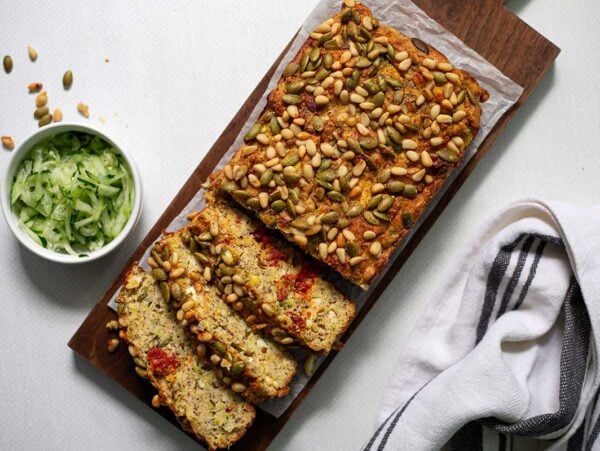










Just wanted to add that I had this in a warm oven while rising. it did not rise at all. My yeast is good . I mixed the yeast with the sugar and water and it bubbled really high. I let it rise for 35 minutes and baked it. It has cooled and it is solid goo on the inside. The flavor is good so I am trying to toast it. Very discouraged. Once again trying to “save” gf bread with the toaster.
Mine just rises. I make this recipe almost weekkly. I have never put it in the oven to rise, maybe it was too hot and killed the yeast. Just sit it in a warm spot in your kitchen and let rise there. If you are sure your yeast is good then that is the only thing I can think that could be wrong.
Carol, I didn’t add that I replaced the eggs with egg replacer. Is this what caused the doughy wet middle? Do you think a flax or chia “egg” would work better? I really would like to try it again. Thank you so much.
Carol, I just tried this recipe, and I love the taste and “solidity” of the bread, but I had two issues on my maiden run:
1. The bread rose, but the expansion was more “out” than “up”.
2. The crust was well into the “brown” range after 40 minutes at 400 degrees. I use an oven thermometer, because I don’t trust my oven, so I’m sure about the temperature.
I’m thinking about adding a touch more xanthan gum and flower to address the first issue, and baking at 375 and checking at 30 minutes to address the second, but I would love your (or anyone’s) input.
Hi Brian,
So many things affect baking. I would try your suggestion of a lower temp and to check it starting at 30 minutes. You want to make sure the bread is hollow sounding when tapped. Regarding your first issue I am wondering if the place you let it rise was too warm? I find that when my kitchen is hot it rises a bit fast and then it goes more out than up. If this isn’t the case then by all means add another 1/2 teaspoon of xanthan gum for extra structiure. Cafefull about adding too much, you don’t want it “gummy”. Good luck!
I usually proof my gluten-based bread in the top oven, which I warm to about 140 degrees and then leave the door cracked. I’ll try the “pan of hot water in a cold oven” approach next time, and hold “mess with the ingredient list” as a last resort. Thanks!
My pleasure, good luck!
Carol, I have a double baguette loaf pan that is 2 1/2 ” wide by 17 1/2 ” long. Your loaf pan looks narrower and shorter than mine. Would mine work and if so how would I adjust the baking time?
It will work just start checking it about 10 minutes sooner on baking time. Make sure they sound hollow, thats the thing otherwise they may be too mosit inside.
At last a recipe that looks like proper bread, tastes like proper bread but is GF. Bread was the one real thing I really missed and this recipe is great! Thanks! Can you make puff pastry? Recipe would be well received
Hi Rachel. Thank you! Puff pastry is not something I have master yet. One day…
I just made your french bread recipe, it’s great .I just started baking gluten free and i could not find a bread recipe that was edible thank you
My pleasure Paulette, happy you enjoyed it!
Second time through went _much_ better – the Worship Council at my church all approved it for our communion services, and one of them told me “If I didn’t know it’s gluten-free, I wouldn’t have known it’s gluten-free.” I took that as high praise.
I have one question about the xantham gum – does it actually _dissolve_ in the oil, or am I just looking to get a good colloidal suspension so that it distributes better in the dough?
Hi Brian. I find that it just kind of makes a thick looking liquid (almost gel-like) but doesn’t fully dissolve. I tried this recipe many ways and found that stirring the xanthan gum into the oil just made it work better. After a little research I discovered that oil makes xantham gum “work” better, so I do it!
Also, do you have any suggestions for how I should change the baking protocol if I want to bake the recipe as a single loaf rather than two loaves?
I have made this as a loaf in a 9 by 5 inch loaf pan, you just may need to bake it longer – the thing you are looking for is that hollow sound. If the top is getting too brown just cover with a pice of foil for the last 10 minutes or so of baking. I would try increasing the time by about 10 minutes or so, but check it. Good luck!
A couple of suggestions based on the batch I baked last night.
1. Substitute 1/3 cup of the flour mix with teff flour. It gives a nice “whole grain” texture to the loaf.
2. Use honey instead of sugar.
3. Add the vinegar to the water and sugar/honey mix for yeast blooming. Yeast like the vitamin C in the vinegar.
I’m going to find a good vegan egg substitute for this recipe, in order to accommodate the vegans in my congregation. Once I find one that works well, I’ll let y’all know.
Thanks Brian!
I’ve made this twice and the second time it worked great! The first time, my loaves were very dense and “yeasty” tasting. The second time, I cut the yeast down to one package of dry active yeast…it bubbled and rose far better than my first attempt. When I left the loaves to rise, they doubled as they should. I think that the first time, I not only used too much yeast, but it may have been old as it took forever to activate and the loaves never doubled in size. I’m just so happy it worked…and was so easy!!!
Hi Lynne yes fresh yeast makes a difference. I am glad to know the recipe works with less yeast too